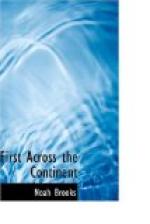“Captain Clark and one of the hunters met, this evening, the largest brown bear we have seen. As they fired he did not attempt to attack, but fled with a most tremendous roar; and such was his extraordinary tenacity of life, that, although he had five balls passed through his lungs, and five other wounds, he swam more than half across the river to a sand-bar, and survived twenty minutes. He weighed between five and six hundred pounds at least, and measured eight feet seven inches and a half from the nose to the extremity of the hind feet, five feet ten inches and a half round the breast, three feet eleven inches round the neck, one foot eleven inches round the middle of the fore leg, and his claws five on each foot, were four inches and three-eighths in length. This animal differs from the common black bear in having his claws much longer and more blunt; his tail shorter; his hair of a reddish or bay brown, longer, finer, and more abundant; his liver, lungs, and heart much larger even in proportion to his size, the heart, particularly, being equal to that of a large ox; and his maw ten times larger. Besides fish and flesh, he feeds on roots and every kind of wild fruit.”
On May 8 the party discovered the largest and most important of the northern tributaries of the Upper Missouri. The journal thus describes the stream:—
“Its width at the entrance is one hundred and fifty yards; on going three miles up, Captain Lewis found it to be of the same breadth and sometimes more; it is deep, gentle, and has a large quantity of water; its bed is principally of mud; the banks are abrupt, about twelve feet in height, and formed of a dark, rich loam and blue clay; the low grounds near it are wide and fertile, and possess a considerable proportion of cottonwood and willow. It seems to be navigable for boats and canoes; by this circumstance, joined to its course and quantity of water, which indicates that it passes through a large extent of country, we are led to presume that it may approach the Saskaskawan (Saskatchewan) and afford a communication with that river. The water has a peculiar whiteness, such as might be produced by a tablespoonful of milk in a dish of tea, and this circumstance induced us to call it Milk River.”
Modern geography shows that the surmise of Captain Lewis was correct. Some of the tributaries of Milk River (the Indian name of which signifies “The River that Scolds at all Others”) have their rise near St. Mary’s River, which is one of the tributaries of the Saskatchewan, in British America.
The explorers were surprised to find the bed of a dry river, as deep and as wide as the Missouri itself, about fifteen miles above Milk River. Although it had every appearance of a water-course, it did not discharge a drop of water. Their journal says:—




